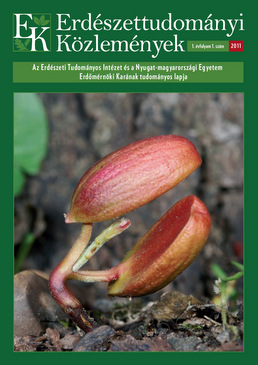Local yield tables for black locust at Nyírség
Károly Rédei, Imre Csiha, Zsolt Keserű, Ágnes Végh Kamandiné & János Rásó
Correspondence
Abstract
In Hungary the black locust (Robinia pseudoacacia L.) can be considered as the most important stand-forming exotic tree species. Due to its favorite growing technological characteristics as well as its wood utilization possibilities the present area occupied by black locust stands amounts to 420 thousand hectares. Of its growing districts Nyírség (North-East Hungary) has a distinguished importance where the area of black locust stands is about 23,000 hectares. To determine their growth rate and yield as exact as possible a local numerical yield table has been constructed on the basis of surveys of the experimental plots established in black locust stands. The yield table can be favourably used for the explanation on the local forest- oriented directives as well.
Keywords: black locust (Robinia pseudoacacia L.), local yield table, Nyírség (North-East Hungary)
| 1. | Birlanescu, E. 1977: Cercetari privind ameliorarea salcamului (Robinia pseudoacacia L.). Studii si cercatari Silvicultura, Bucuresti. 3: 441–453. |
| 2. | Bridgen, M.R. 1992: Plantation silviculture of black locust. In Hanover, J.W., Plesko, S. (eds). Black locust: Biology, Culture and Utilization. Proceedings.Michigan State University, USA. 21–32. |
| 3. | Fekete Z. 1937: Akác fatermési táblák a Magyar Alföld számára. Sopron. |
| 4. | Fekete Z. 1960: Akácosok újrafelvételének eredményei. Erdészeti Kutatások, (56): 3–43. |
| 5. | Keresztesi B. 1986: Az akác termesztése rövid vágásfordulóban. Erdészeti Kutatások, (78): 15–28. |
| 6. | Kohán S. 2007: Niektoré vysledky hodnotenia rastu a objemovej produkcie agáta bieleho (Robinia pseudoacacia L.) prirozlicnych sposoboch pestovania v oblasti vychodoslo-venskej níziny. Lesnícky casopis – Forestry Journal (53): 107–116. |
| 7. | Park, Y.G. 1996: The prospects for the utilisation of Robinia pseudoacacia in Korea. Kor. J. Apicult. (11): 25–57. |
| 8. | Rédei K. 1984: Akácosok fatermése. ERTI Kutatási jelentés. Kecskemét. |
| 9. | Rédei K. és Gál J. 1985: Akácosok fatermése. Erdészeti Kutatások, (76–77): 195–203. |
| 10. | Rédei K. 1995: A növedékfokozó gyérítések hatása az akácosok (Robinia pseudoacacia L.) hozam- és értékváltozására. Erdészeti Kutatások, (85): 79–90. |
| 11. | Rédei K. 1997: The Effect of Regeneration Methods on the Yield of Black Locust (Robinia pseudoacacia L.) Stands in Hungary. Silva Lusitana, 5(1): 71–77. |
| 12. | Rédei K. 2005: A gyökérsarjról történő akác-felújítási mód megválasztásának fatermési kritériumai. Erdészeti Lapok. CXL. (11): 324–325. full text |
| 13. | Rédei K. 2006: Az akác termesztés-fejlesztésének biológiai alapjai és gyakorlata. Agroinform Kiadó, Budapest. |
| 14. | Rédei K. and Meilby H. 2009: Effect of Thinning on the Diameter Increment in Black Locust (Robinia pseudoacacia L.) Stands. Acta Silvatica and Lignaria Hungarica, (5): 63–74. full text |
| 15. | Sopp L. 1974: Fatömegszámítási táblázatok. Mezőgazdasági Kiadó, Budapest. |
Birlanescu, E. 1977: Cercetari privind ameliorarea salcamului (Robinia pseudoacacia L.). Studii si cercatari Silvicultura, Bucuresti. 3: 441–453. Bridgen, M.R. 1992: Plantation silviculture of black locust. In Hanover, J.W., Plesko, S. (eds). Black locust: Biology, Culture and Utilization. Proceedings.Michigan State University, USA. 21–32. Fekete Z. 1937: Akác fatermési táblák a Magyar Alföld számára. Sopron. Fekete Z. 1960: Akácosok újrafelvételének eredményei. Erdészeti Kutatások, (56): 3–43. Keresztesi B. 1986: Az akác termesztése rövid vágásfordulóban. Erdészeti Kutatások, (78): 15–28. Kohán S. 2007: Niektoré vysledky hodnotenia rastu a objemovej produkcie agáta bieleho (Robinia pseudoacacia L.) prirozlicnych sposoboch pestovania v oblasti vychodoslo-venskej níziny. Lesnícky casopis – Forestry Journal (53): 107–116. Park, Y.G. 1996: The prospects for the utilisation of Robinia pseudoacacia in Korea. Kor. J. Apicult. (11): 25–57. Rédei K. 1984: Akácosok fatermése. ERTI Kutatási jelentés. Kecskemét. Rédei K. és Gál J. 1985: Akácosok fatermése. Erdészeti Kutatások, (76–77): 195–203. Rédei K. 1995: A növedékfokozó gyérítések hatása az akácosok (Robinia pseudoacacia L.) hozam- és értékváltozására. Erdészeti Kutatások, (85): 79–90. Rédei K. 1997: The Effect of Regeneration Methods on the Yield of Black Locust (Robinia pseudoacacia L.) Stands in Hungary. Silva Lusitana, 5(1): 71–77. Rédei K. 2005: A gyökérsarjról történő akác-felújítási mód megválasztásának fatermési kritériumai. Erdészeti Lapok. CXL. (11): 324–325. full text Rédei K. 2006: Az akác termesztés-fejlesztésének biológiai alapjai és gyakorlata. Agroinform Kiadó, Budapest. Rédei K. and Meilby H. 2009: Effect of Thinning on the Diameter Increment in Black Locust (Robinia pseudoacacia L.) Stands. Acta Silvatica and Lignaria Hungarica, (5): 63–74. full text Sopp L. 1974: Fatömegszámítási táblázatok. Mezőgazdasági Kiadó, Budapest.
For non-commercial purposes, let others distribute and copy the article, and include in a collective work, as long as they cite the author(s) and the journal, and provided they do not alter or modify the article.
Cite this article as:
Rédei, K., Csiha, I., Keserű, Zs., Kamandiné, V. Á. & Rásó, J. (2011): Local yield tables for black locust at Nyírség. Bulletin of Forestry Science, 1(1): 115-124. (in Hungarian)

Volume 1, Issue 1
Pages: 115-124
First published:
1 September 2011
More articles
by this authors
